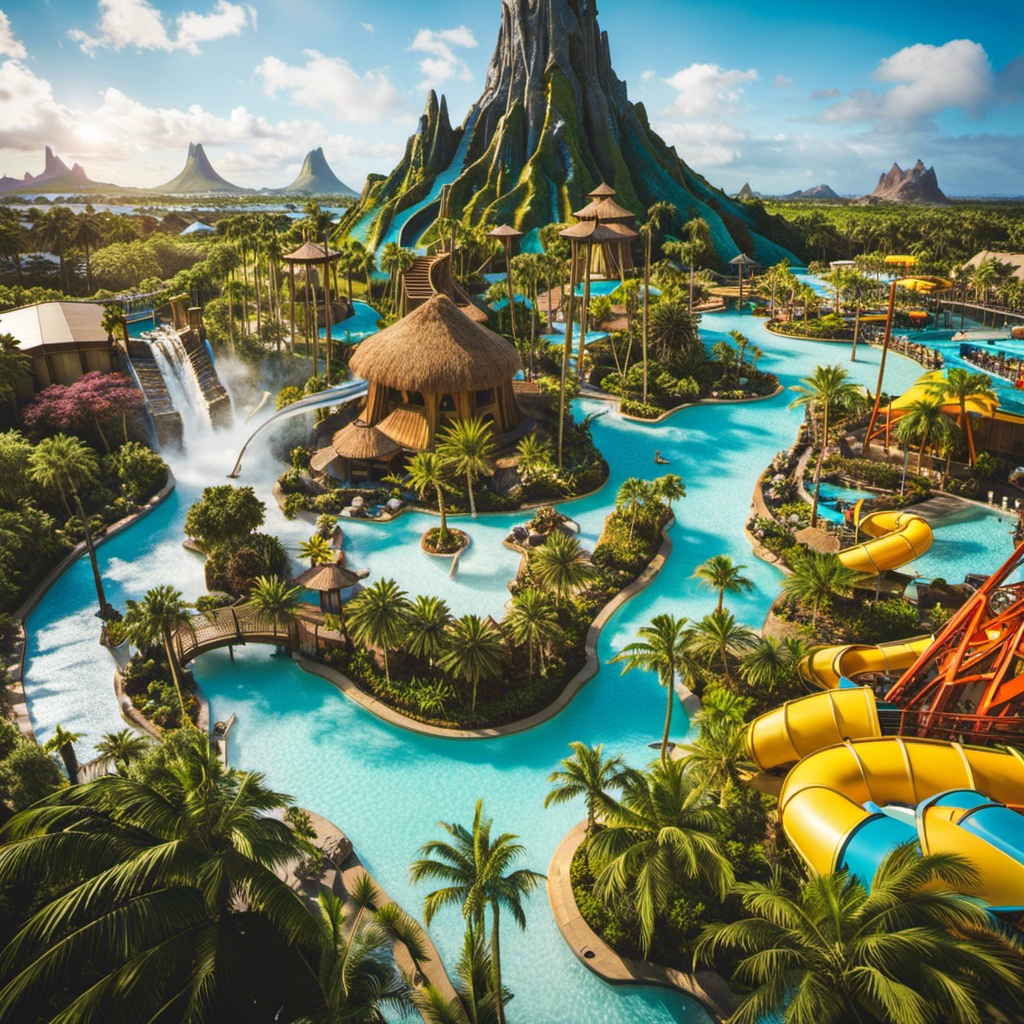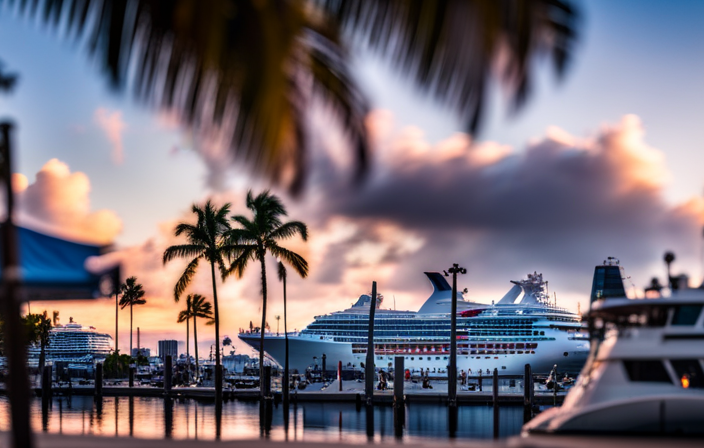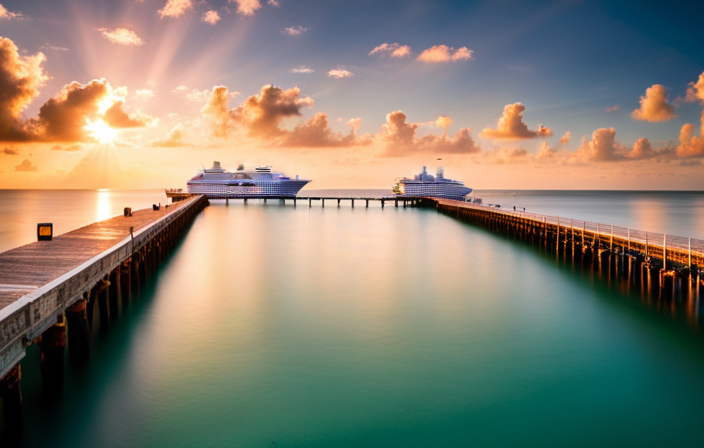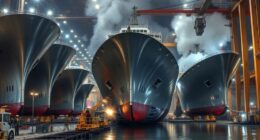Having journeyed extensively, I find myself consistently drawn to the splendor and allure of cruise ships. These opulent, vibrant floating cities seem to forever cruise the vast oceans gracefully.
But have you ever wondered just how long these magnificent vessels stay in service? In this article, we delve deep into the factors that affect the lifespan of cruise ships, from maintenance and regulations to environmental considerations.
So, come aboard as we embark on a journey to uncover the secrets behind the longevity of these maritime marvels.
Key Takeaways
- Regular maintenance and upgrades are essential for increasing the lifespan of cruise ships.
- Sustainable practices and environmental considerations play a crucial role in the retirement and decommissioning of cruise ships.
- Economic factors heavily influence the decision to retire or continue operating a cruise ship.
- Profitability and revenue generation are crucial for a cruise ship to stay in service.
Factors Affecting Cruise Ship Lifespan
If you take good care of your cruise ship, it’ll typically stay in service for around 30 years. This lifespan can be influenced by several factors, including maintenance costs and the impact on local economies.
Cruise ships require regular maintenance to ensure their safety and functionality. These costs can add up over time, especially for older ships that may require more extensive repairs.
Additionally, the impact on local economies is an important consideration. Cruise ships bring tourists to various destinations, boosting local businesses and generating revenue. However, their environmental impact and overcrowding issues can also have negative consequences.
Balancing the economic benefits with the potential drawbacks is crucial in determining the lifespan of a cruise ship. Considering these factors, it becomes evident that the average lifespan of cruise ships is influenced by a multitude of variables.
Average Lifespan of Cruise Ships
When considering the average lifespan of cruise ships, there are several key factors that impact their longevity.
First, maintenance and upgrades play a crucial role in extending the lifespan of these vessels. Regular inspections, repairs, and technological advancements help ensure the ship remains in optimal condition.
Additionally, sustainability and environmental impact have become increasingly important factors, with a focus on reducing emissions and implementing green practices to minimize the ship’s ecological footprint.
Factors Impacting Lifespan
One of the factors that can impact the lifespan of a cruise ship is the level of maintenance and repairs carried out on a regular basis. Adequate funding is crucial for ensuring that the necessary maintenance and repairs are conducted promptly. However, cruise lines often face funding challenges, especially during economic downturns or unforeseen circumstances such as the recent COVID-19 pandemic.
Additionally, natural disasters can have a significant impact on the lifespan of cruise ships. Hurricanes, tsunamis, and other extreme weather events can cause extensive damage to the vessels, requiring extensive repairs or even rendering them unsalvageable. These natural disasters can also disrupt the overall operation of the cruise industry, leading to decreased revenue and potentially affecting the financial viability of the ships.
Nonetheless, it is crucial for cruise lines to address these challenges and ensure proper maintenance and repairs to extend the lifespan of their ships.
As cruise ships age, the need for maintenance and upgrades becomes increasingly important.
Maintenance and Upgrades
To ensure the longevity of your vessel, regular maintenance and upgrades are essential. Maintaining a cruise ship is no easy task, as it faces a range of maintenance challenges throughout its service life. From corrosion and wear and tear to mechanical failures and safety compliance, staying on top of maintenance is crucial.
Additionally, keeping a cruise ship up to date with the latest technology and amenities requires costly upgrades. These upgrades can include everything from installing new entertainment systems and restaurants to implementing energy-efficient technologies. However, despite the cost of these upgrades, they are necessary to attract passengers and remain competitive in the industry.
As we explore the sustainability and environmental impact of cruise ships, it is important to consider how these maintenance challenges and costs play a role in shaping the industry’s future.
Sustainability and Environmental Impact
Regular maintenance and upgrades are crucial for cruise ships to minimize their environmental impact and ensure sustainability. With the growing focus on green shipbuilding and sustainable tourism, cruise ship operators are implementing various measures to reduce their carbon footprint and preserve the marine environment.
These measures include the use of advanced wastewater treatment systems, the installation of energy-efficient technologies, and the adoption of alternative fuels. Additionally, cruise lines are investing in innovative hull designs and propulsion systems that optimize fuel consumption and reduce emissions.
By implementing these sustainable practices, cruise ships can operate more efficiently and responsibly, minimizing their impact on the environment. This commitment to sustainability is essential for the long-term viability of the cruise industry and its ability to meet the demands of environmentally conscious travelers.
Moving forward, it is important to continue prioritizing sustainability in the maintenance and upkeep of cruise ships, ensuring that they remain environmentally friendly throughout their service life.
Maintenance and Upkeep of Cruise Ships
Cruise ships require regular maintenance and upkeep to ensure they stay in service for a long time. Sustainability practices and cost-effective maintenance strategies are key in keeping these massive vessels operational while minimizing their environmental impact.
By implementing sustainable practices, cruise lines can reduce their carbon footprint and contribute to the preservation of our oceans. Additionally, cost-effective maintenance strategies help cruise ships achieve optimal performance without breaking the bank. This can involve routine inspections, repairs, and upgrades to ensure the ship’s systems are functioning efficiently.
It’s crucial to prioritize preventive maintenance to catch potential issues before they become major problems. In doing so, cruise ships can extend their service life and provide memorable experiences to passengers for years to come. However, there comes a time when retirement and decommissioning become inevitable, and the ship’s journey comes to an end.
Retirement and Decommissioning of Cruise Ships
When it comes to the retirement and decommissioning of cruise ships, two key points need to be considered.
Firstly, the average ship lifespan is an important factor to take into account. This lifespan can vary depending on factors such as maintenance, technological advancements, and market demand. Understanding the average ship lifespan is crucial in determining when a cruise ship should be retired and decommissioned.
Secondly, decommissioning a cruise ship can have significant environmental implications. This process involves the disposal of hazardous materials and the proper handling of waste. Therefore, careful consideration must be given to the environmental impact to ensure sustainable practices are followed during the decommissioning process.
Overall, both the average ship lifespan and the environmental impact of decommissioning play crucial roles in the retirement of cruise ships.
Average Ship Lifespan?
The average ship lifespan for cruise ships is typically around 30 years. Several factors can affect the longevity of a cruise ship, including maintenance, technological advancements, and changes in consumer preferences. The impact of maintenance on a ship’s lifespan cannot be overstated. Regular inspections, repairs, and upgrades are essential to keep the ship functioning safely and efficiently. Neglecting maintenance can lead to costly breakdowns and potentially shorten the ship’s lifespan.
To illustrate the importance of maintenance, here is a table showcasing the impact of different maintenance practices on a ship’s lifespan:
| Maintenance Practice | Impact on Ship Lifespan |
|---|---|
| Regular inspections | Increases lifespan |
| Timely repairs | Increases lifespan |
| Upgrading technology | Increases lifespan |
| Neglecting maintenance | Shortens lifespan |
| Inadequate repairs | Shortens lifespan |
Considering the crucial role of maintenance in determining a ship’s lifespan, it becomes evident that proper upkeep is essential for the longevity of cruise ships.
Transitioning to the subsequent section about the environmental impact of decommissioning, it is important to address the question of how cruise ships are retired and the consequences of their disposal.
Environmental Impact of Decommissioning?
Transitioning to the environmental impact of decommissioning, it’s crucial to consider how cruise ships are retired and the consequences of their disposal.
When a cruise ship reaches the end of its service life, various decommissioning methods are employed to retire the vessel. One common approach is shipbreaking, where the ship is dismantled for its materials. However, this process can have detrimental effects on the environment due to the release of hazardous substances.
To mitigate these impacts, recycling initiatives have been implemented in the cruise industry. These initiatives aim to recycle and reuse as much of the ship’s materials as possible, reducing the need for new resources and minimizing waste.
By implementing responsible decommissioning methods and supporting recycling initiatives, the environmental consequences of retiring cruise ships can be minimized.
Transitioning to extending the lifespan of cruise ships, it is important to consider ways to prolong their service and reduce waste.
Extending the Lifespan of Cruise Ships
Extending the lifespan of cruise ships can be achieved through regular maintenance and upgrades. By implementing sustainable practices, cruise ship operators can ensure that their vessels remain in service for longer periods of time, reducing the need for premature decommissioning.
This involves conducting routine inspections, repairing any structural damage, and replacing worn-out components. Additionally, incorporating energy-efficient technologies and alternative fuel sources can contribute to reducing the environmental impact of cruise ships. For example, installing advanced waste management systems and utilizing renewable energy sources can help minimize pollution and greenhouse gas emissions.
By adopting these sustainable practices, cruise ships can not only extend their lifespan but also contribute to a more environmentally-friendly industry.
Now, let’s delve into the impact of technological advancements on cruise ship lifespan.
The Impact of Technological Advancements on Cruise Ship Lifespan
With advancements in technology, you can enhance the lifespan of your cruise ship by integrating state-of-the-art navigation systems and advanced safety features. These technological advancements have had a significant impact on the cruise industry, improving both the efficiency and safety of these massive vessels.
Here are three key ways in which automation and technological advancements have influenced the lifespan of cruise ships:
-
Automation of navigation systems allows for more precise and efficient maneuvering, reducing wear and tear on the ship’s components.
-
Advanced safety features, such as collision avoidance systems and emergency response protocols, minimize the risk of accidents and potential damage to the ship.
-
Improved maintenance and monitoring systems enable early detection of potential issues, allowing for timely repairs and preventing further damage.
By leveraging these advancements, cruise ship operators can extend the lifespan of their vessels, ensuring a safer and more reliable service for passengers.
As we consider the impact of technology on cruise ship lifespan, it is also essential to address the environmental considerations in cruise ship service.
Environmental Considerations in Cruise Ship Service
When it comes to environmental considerations in cruise ship service, two key points that are worth discussing are green ship technologies and emission reduction strategies.
Green ship technologies encompass a range of innovative solutions aimed at minimizing the environmental impact of cruise ships. These solutions include using cleaner fuels, implementing energy-efficient systems, and adopting waste management practices.
On the other hand, emission reduction strategies focus on reducing the release of harmful pollutants into the atmosphere. Initiatives such as scrubbers, catalytic converters, and the use of shore power while docked are employed to achieve this goal.
These topics are crucial in addressing the industry’s environmental footprint and promoting sustainable practices.
Green Ship Technologies
You’ll be interested to know that cruise ships are adopting Green Ship Technologies to reduce their environmental impact.
These technologies encompass a wide range of emission reduction strategies that aim to minimize the negative effects of cruise ship operations on the environment.
One such strategy is the use of alternative fuels, such as liquefied natural gas (LNG) or biofuels, which produce lower levels of harmful emissions compared to traditional marine fuels.
Additionally, cruise ships are implementing advanced wastewater treatment systems to ensure that any discharged water meets strict environmental standards.
Furthermore, the installation of exhaust gas cleaning systems, also known as scrubbers, helps to remove pollutants from the ship’s exhaust gases.
These Green Ship Technologies play a crucial role in mitigating the environmental impact of cruise ships and paving the way for a more sustainable future in the industry.
Emission Reduction Strategies
If you’re looking for ways to reduce emissions, consider implementing various strategies like using alternative fuels and installing exhaust gas cleaning systems. These emission reduction strategies are crucial in the maritime industry, especially for cruise ships, as they contribute to air pollution and climate change.
To effectively reduce emissions, here are two key approaches to consider:
-
Utilizing alternative fuels:
-
Biofuels: Made from organic matter, biofuels reduce carbon dioxide emissions and improve air quality.
-
LNG (liquefied natural gas): Cleaner than traditional fuels, LNG reduces sulfur and nitrogen oxide emissions.
-
Installing exhaust gas cleaning systems:
-
Scrubbers: These systems remove harmful pollutants from ship exhausts, such as sulfur oxides and particulate matter.
-
Selective Catalytic Reduction (SCR): SCR systems reduce nitrogen oxide emissions by converting them into harmless nitrogen and water.
Implementing these emission reduction strategies, alongside green ship technologies, can significantly reduce the environmental impact of cruise ships. This sets the stage for the subsequent discussion on the role of safety regulations in cruise ship service duration, ensuring a comprehensive understanding of the factors influencing ship operations.
The Role of Safety Regulations in Cruise Ship Service Duration
To ensure the longevity of cruise ship service, safety regulations play a crucial role. The implementation of strict safety regulations is essential in maintaining the overall integrity and functionality of cruise ships. These regulations cover various aspects, including structural integrity, fire safety, life-saving equipment, and emergency procedures.
Cruise ship maintenance, which is guided by these safety regulations, involves regular inspections, repairs, and upgrades to ensure that the vessel remains in optimal condition. This includes routine checks on the hull, propulsion systems, electrical systems, and safety equipment. By adhering to these regulations and conducting proper maintenance, cruise ship operators can mitigate potential risks and ensure the safety of passengers and crew members.
Furthermore, these regulations contribute to the overall lifespan of cruise ships, as they help prevent accidents and incidents that could lead to premature retirement or even the loss of the vessel.
Transitioning into the subsequent section about economic factors in determining cruise ship lifespan, it is important to consider that while safety is paramount, economic factors also play a significant role in determining how long a cruise ship stays in service.
Economic Factors in Determining Cruise Ship Lifespan
When considering the lifespan of a cruise ship, economic factors heavily influence how long it remains in operation. The economic implications and financial considerations play a crucial role in determining whether a cruise ship continues to sail the seas or is retired.
Cruise ships are expensive to build and maintain, and their profitability is closely tied to passenger demand and market conditions. A ship that is not generating enough revenue to cover its operating costs may be forced into early retirement. Additionally, the cost of complying with safety regulations and implementing necessary upgrades can also impact a ship’s economic viability.
Therefore, cruise lines carefully evaluate the financial performance of their vessels and make strategic decisions based on profitability. With these economic factors in mind, let’s now explore case studies of the longest serving cruise ships, showcasing their impressive lifespan and enduring popularity.
Case Studies: Longest Serving Cruise Ships
With impressive lifespans and enduring popularity, several cruise ships have served the industry for an extended period. These long-serving vessels hold a significant place in the history of cruising, showcasing the evolution and growth of the industry over time.
One such example is the MS Queen Elizabeth 2, which served as an iconic symbol of luxury for nearly 40 years. Launched in 1969, this ship transported countless passengers and played a vital role in shaping the modern cruising experience.
Another notable long-serving ship is the MS Rotterdam, which has been sailing since 1997. As one of the most beloved ships in the Holland America Line fleet, the Rotterdam has become synonymous with elegance and sophistication.
These long-serving cruise ships not only represent the longevity of the industry, but also hold a historical significance in the hearts of cruise enthusiasts worldwide.
Frequently Asked Questions
How Many Cruise Ships Are Currently in Service Worldwide?
Currently, there are approximately 300 cruise ships in service worldwide. The cruise ship market has experienced significant growth in recent years, with new ships being added to fleets and older ones retiring to keep up with demand.
What Is the Average Age of a Cruise Ship When It Is Retired?
On average, cruise ships retire at around 30 years old. This retirement age has a significant impact on the cruise industry, as it necessitates continuous investment in new vessels to meet demand and maintain a modern fleet.
Are There Any Regulations in Place Regarding the Disposal of Retired Cruise Ships?
There are regulations in place regarding the disposal of retired cruise ships. These regulations ensure that scrapping methods are conducted in an environmentally responsible manner, minimizing the impact on marine ecosystems and human health.
How Do Cruise Ship Companies Decide When It’s Time to Retire a Ship?
How do cruise ship companies decide when it’s time to retire a ship? They use retirement criteria based on factors like the ship’s age, condition, and profitability. Economic factors also play a role in determining if a ship should be retired or not.
Are There Any Efforts Being Made to Make Cruise Ships More Environmentally Friendly?
Efforts are being made to make cruise ships more environmentally friendly through technology advancements. Companies are investing in cleaner fuel options, implementing waste management systems, and adopting energy-efficient practices to reduce their environmental impact.
Conclusion
In conclusion, the lifespan of cruise ships is influenced by a variety of factors. These factors include maintenance, environmental considerations, safety regulations, and economic factors. Just like a well-oiled machine, these majestic vessels require careful upkeep to ensure their longevity.
However, even the most durable ships eventually reach their retirement age. The world of cruise ships is a fascinating one, with each vessel having its own unique story to tell.
They are like graceful dancers, gliding across the seas, bringing joy and adventure to their passengers.










